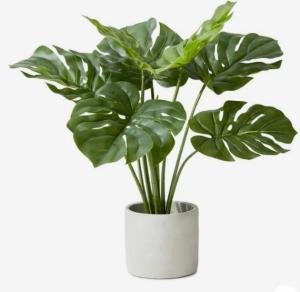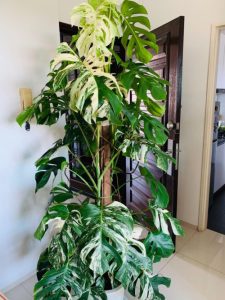Native to the jungles of Central America, evergreen monstera is Its exquisite look and unusual lobed leaves make it quite famous. Knowing the appropriate growth conditions for Monstera helps one to maintain it robust and healthy at home.

Monstera
Light needs
Usually growing in the shadow of trees in its natural habitat, monstera is endemic to the understory of the rainforest and not demanding of light. Monstera prefers strong indirect light. Too intense sunshine may scorch their leaves, turning them yellow or featuring dry patches. But if there is less light, Monstera’s development rate may slow down and its cosmetic value may suffer from reduced cracks and holes on the leaves. Consequently, Monstera should be kept inside in an area with strong but not too direct light, say next to an east-facing or north-facing window. Should insufficient natural light be present, you might want to think about augmenting the light with artificial lighting; however, be cautious not to use too intense light.
Temporal settings
Is a tropical plant hence it is very sensitive to temperature; the appropriate range is 18°C to 27°C. A too low temperature will stop its development and maybe kill the plant. Is not suited for cold. The leaves might be frostbitten, displaying blackening or withering, when the temperature is below 10°C. Particularly in cold northern areas, additional attention should be made to temperature regulation in winter to prevent planting the plant in an environment where the temperature drops drastically or in direct path of cold wind. Conversely, even while too high temperatures won’t immediately damage the plant, they could hasten water evaporation and raise its water need.
Requirements regarding humidity
Original habitat in the tropical rainforest is closely matched by its preferred high humidity surroundings. Maintaining a quite high air humidity can help Monstera grow healthily in its native environment as the air humidity is generally over 60%. Particularly in the dry winter, when interior air humidity is often low, low humidity may cause the leaf margins to dry out. To raise the atmospheric humidity, one is advised to routinely mist the leaves with humidifier or spray water. Furthermore helping the Monstera satisfy its humidity requirements is keeping it in an area with high humidity, such a bathroom or kitchen.
Choose of soil
The Monstera’s soil needs mostly concern drainage and air permeability. The Monstera likes loose soil high in organic content, which may minimise waterlogging and root rot while also supplying enough oxygen for the roots of the plant. One is advised to combine pine needle soil, perlite, and peat ground. Appropriate for the Monstera’s development requirements, this mixed matrix may preserve adequate drainage and provide enough water retention. Furthermore put to the soil to increase its fertility and encourage the healthy development of the Monstera might be some leaf mould or decomposing organic fertiliser.
Air flow
Particularly in a high humidity surroundings, the health of the Monstera depends on good air circulation. By use of air circulation, the plant can eliminate extra water and stop the development of fungus and mould. Leaf rot or pests and diseases are readily caused in an area where the Monstera is in inadequate air circulation for a protracted period. Thus, it is important to provide enough ventilation inside throughout the repair procedure, particularly in summer and seasons with great humidity. While you should use fans to boost air flow or open windows for ventilation, you should avoid direct strong winds blowing on the plants.
Watering practices
The secret to Monstera growing healthily is reasonable watering. Monstera like a damp but waterless surroundings. Whereas too little water may cause the leaves to wither, too much water can induce root rot. Usually, it is advised to water following the dry surface of the ground. While the quantity of water should be cut in winter and the dormant period, the frequency of watering should be suitably raised in summer and the growth season. Moreover, try to minimise water collection on the leaves to stop leaf rot or disease during watering. Watering with warm water helps the plant absorb it and more faithfully reflects its natural growing environment.
Fertiliser needs
Particularly at the height of growth, monstera needs enough nutrients for development. Usually speaking, a balanced liquid fertiliser may be sprayed every two to four weeks to provide required nutrients like nitrogen, phosphorous, and potassium. Monstera’s health will suffer either from too much or too little fertilisation. Excessive fertiliser might burn the root system and result in yellow or wilt of the plant. Thus, when fertilising, you should focus on managing the quantity and modify it depending on the state of development of the plant. You should cut or cease fertilising when the plant becomes dormant in winter to prevent overconsuming its energy.
Pest and disease control
Even while Monstera is a somewhat disease-resistant plant, under unfavourable climatic circumstances pests and diseases may still attack it. Among common pests and illnesses include scale insects, red spiders, and leaf spot diseases. The plants should be examined often, excellent ventilation should be maintained, and issues should be addressed right away when they are discovered in order to stop pests and diseases from striking them. While in extreme situations appropriate insecticides may be needed, mild pests may be managed by cleaning the leaves with soapy water or alcohol. Furthermore a good way to stop pests and illnesses from spreading is cutting off sick leaves.
Space of cultivation
Develops quickly in a proper habitat, particularly in view of enough nutrients and sunshine. Thus, enough room for development should be set out for it during cultivation. Since monstera may reach several meters tall and its leaves occupy a lot of space when unfurled, it is advisable to choose a broad, clear area for indoor growth of it. Pruning the plant will assist you to regulate its development if room is restricted and guarantee it adequate support to enable it to climb and unfurl.

Monstera
Popular indoor decorative plants, Monstera’s healthy development relies on suitable light, temperature, humidity, soil, air movement, water, fertiliser management, insect control, and enough growing area. Providing Monstera with growing circumstances comparable to its natural rainforest habitat would not only guarantee the development of cracks and holes in its leaves, thus enhancing its beauty worth, but also help it to grow inside for a long period, so displaying a distinctive tropical style.
Post time: 08-24-2024




